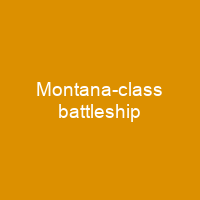The Montana-class battleships were planned as successors of the Iowa class for the United States Navy. Five were approved for construction during World War II, but changes in wartime building priorities resulted in their cancellation. Intended armament would have been twelve 16-inch Mark 7 guns in four 3-gun turrets, up from the nine Mark7 guns in three turrets used by the Iowaclass.
About Montana-class battleship in brief

of Midway, diminished the perceived value of the battleship. The US Navy chose to cancel the Montanaclass in favor of more urgently needed aircraft carriers, amphibious and anti-submarine vessels. Because the Iowas were far along enough in construction and urgently needed to operate alongside the new Essex-class aircraft carriers,. their orders were retained, making them the last U. S. Navy battleship to be commissioned. By 1942, it was apparent to US Navy high command that they needed as many fast battleships as possible, and hull numbers BB- 65 and BB66 were allocated to planned Iowa- Class battleships Illinois andKentucky. Preliminary design work for the MontanaClass began before the US entry into World War Two. The Navy had been considering large battleship design schemes since 1938 to counter the threat posed by potential battleships of the Imperial Japanese Navy. Although the Navy knew little about the Yamato class, some rumors regarding the new Japanese battleships placed main gun battery caliber at 18 inches. The potential of naval treaty violations by the newJapanese battleships resulted in the remaining treaty powers, Britain, France and the United. States, invoking the maximum standard displacement limit from 35,000 long tons. The increased displacement limit allowed the Navy to begin evaluating 45,000-ton battleship designs, including \”slow\” 27-knot schemes that increased firepower and protection over previous designs and also \”fast\” 33-k NOT schemes.
You want to know more about Montana-class battleship?
This page is based on the article Montana-class battleship published in Wikipedia (as of Dec. 08, 2020) and was automatically summarized using artificial intelligence.







